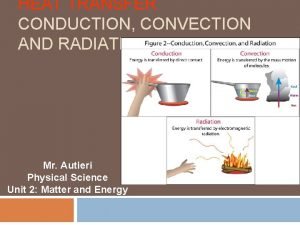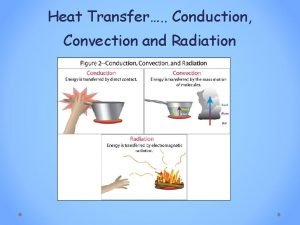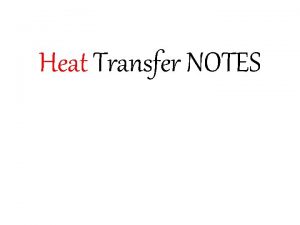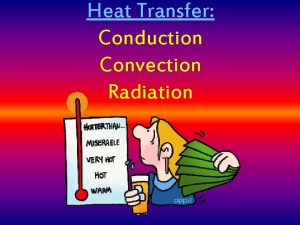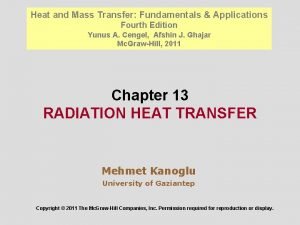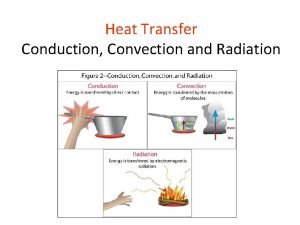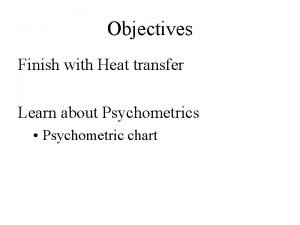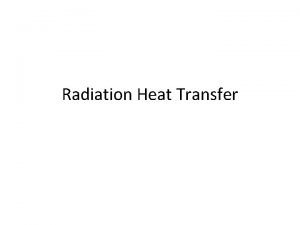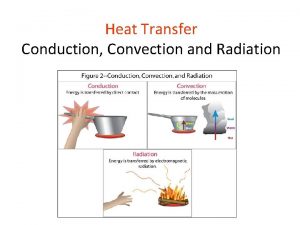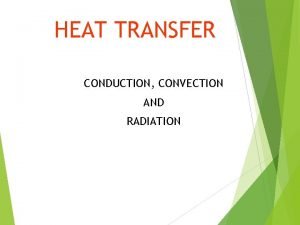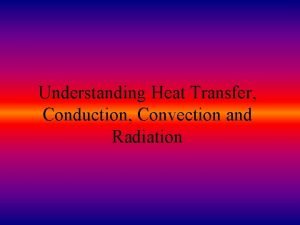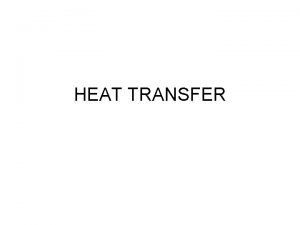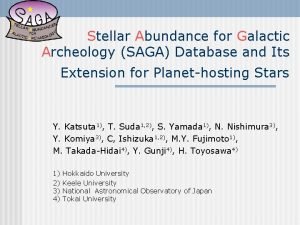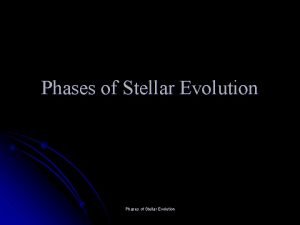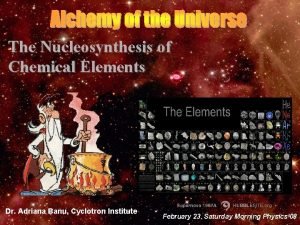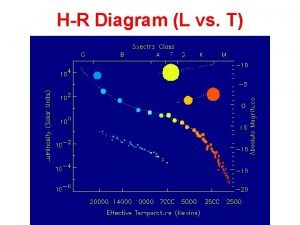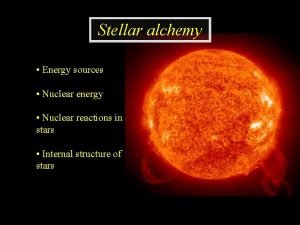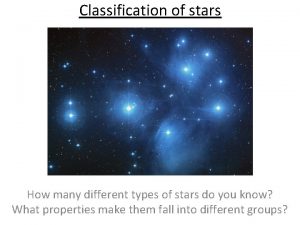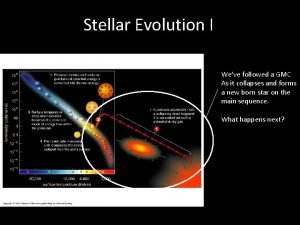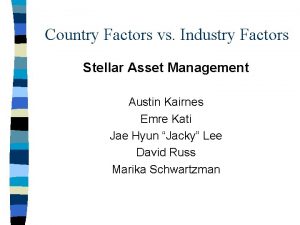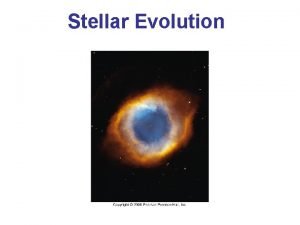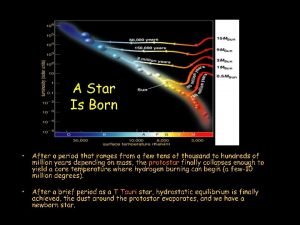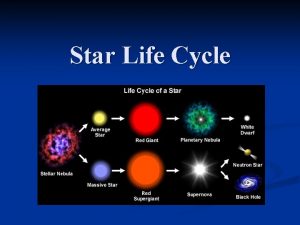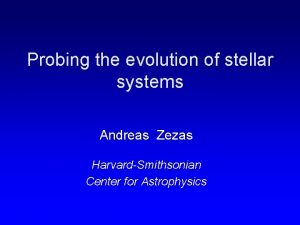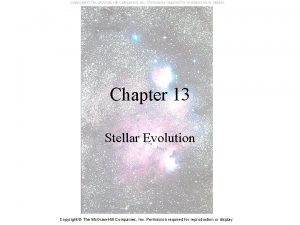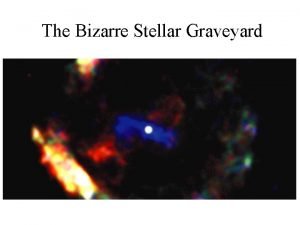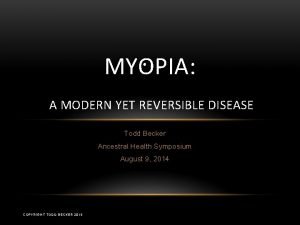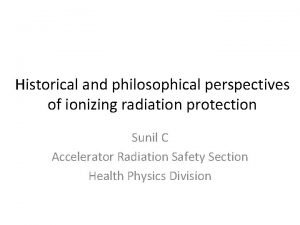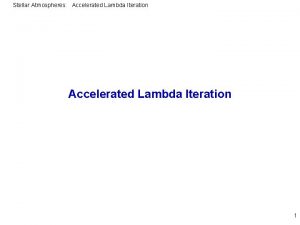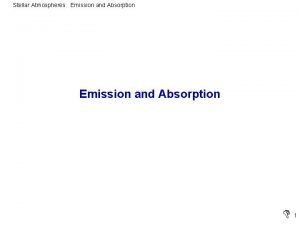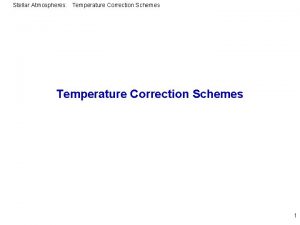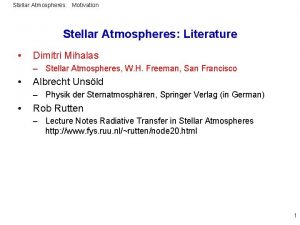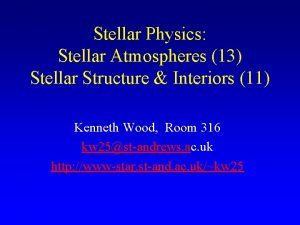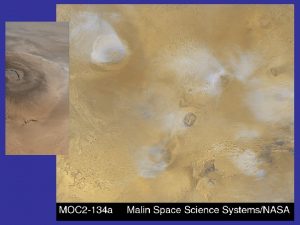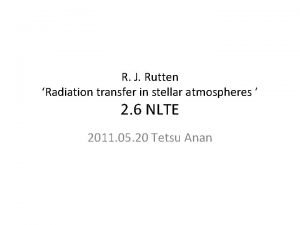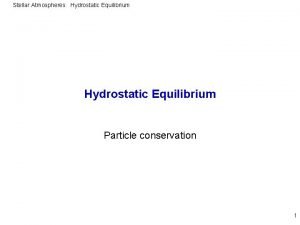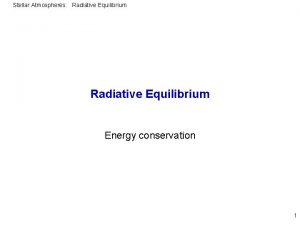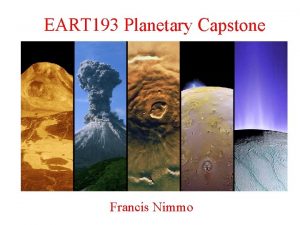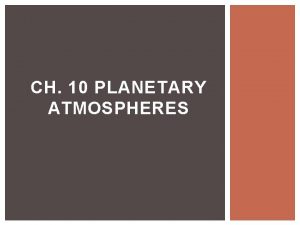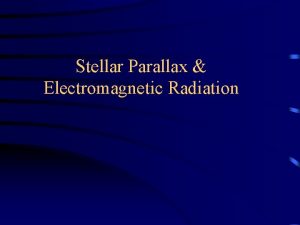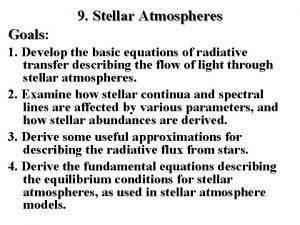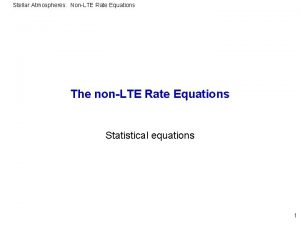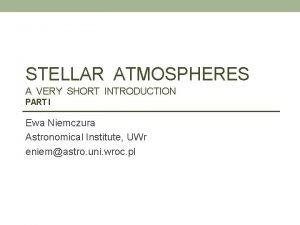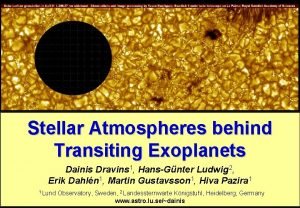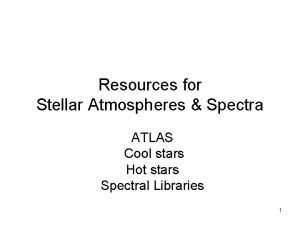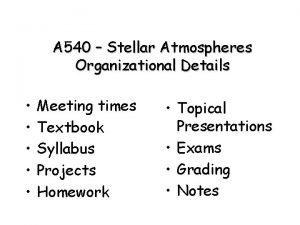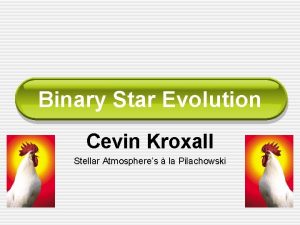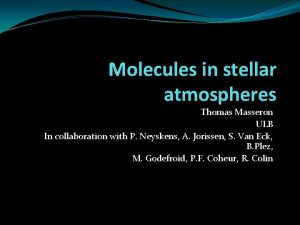Stellar Atmospheres Radiation Transfer 1 Stellar Atmospheres Radiation







































- Slides: 39

Stellar Atmospheres: Radiation Transfer 1

Stellar Atmospheres: Radiation Transfer Interaction radiation – matter Energy can be removed from, or delivered to, the radiation field Classification by physical processes: True absorption: True emission: Scattering: photon is destroyed, energy is transferred into kinetic energy of gas; photon is thermalized photon is generated, extracts kinetic energy from the gas photon interacts with scatterer direction changed, energy slightly changed no energy exchange with gas 2

Stellar Atmospheres: Radiation Transfer Examples: true absorption and emission • photoionization (bound-free) excess energy is transferred into kinetic energy of the released electron effect on local temperature • photoexcitation (bound-bound) followed by electron collisional de-excitation; excitation energy is transferred to the electron effect on local temperature • photoexcitation (bound-bound) followed by collisional ionization • reverse processes are examples for true emission 3

Stellar Atmospheres: Radiation Transfer Examples: scattering processes • 2 -level atom absorbs photon with frequency 1, re-emits photon with frequency 2; frequencies not exactly equal, because b 1 2 a – levels a and b have non-vanishing energy width – Doppler effect because atom moves • Scattering of photons by free electrons: Compton- or Thomson scattering, (anelastic or elastic) collision of a photon with a free electron 4

Stellar Atmospheres: Radiation Transfer Fluorescence Neither scattering nor true absorption process c b a c-b: collisional de-excitation b-a: radiative 5

Stellar Atmospheres: Radiation Transfer Change of intensity along path element generally: plane-parallel geometry: spherical geometry: 6

Stellar Atmospheres: Radiation Transfer Plane-parallel geometry dt ds geometrical depth t outer boundary 7

Stellar Atmospheres: Radiation Transfer Spherical geometry dr +d ds -rd -d 8

Stellar Atmospheres: Radiation Transfer Change of intensity along path element generally: plane-parallel geometry: spherical geometry: 9

Stellar Atmospheres: Radiation Transfer Right-hand side of transfer equation • No absorption (vacuum) invariance of intensity • Absorption only, no emission energy removed from ray: is proportional to energy content in ray: and to the path element: 10

Stellar Atmospheres: Radiation Transfer Absorption coefficient • • • thus: absorption coefficient, opacity dimension: 1/length unit: cm-1 but also often used: mass absorption coefficient, e. g. , per gram matter in general complicated function of physical quantities T, P, and frequency, direction, time. . . • often there is a coordinate system in which isotropic, e. g. co-moving frame in moving atmospheres • counter-example: magnetic fields (Zeeman effect) 11

Stellar Atmospheres: Radiation Transfer outer boundary dt ds geometrical depth t only absorption, plane-parallel geometry 12

Stellar Atmospheres: Radiation Transfer Schuster boundary-value problem =0 outer boundary = max inner boundary 13

Stellar Atmospheres: Radiation Transfer Example: homogeneous medium e. g. glass filter I+ I d/ s - d/| | s 14

Stellar Atmospheres: Radiation Transfer Half-width thickness Material S 1/2 / meter River water 0. 033 Window glass 0. 066 City air 330 Glas fiber 6600 Solar atmosphere 200000 15

Stellar Atmospheres: Radiation Transfer Physical interpretation of optical depth What is the mean penetration depth of photons into medium? 0 1 16

Stellar Atmospheres: Radiation Transfer The right-hand side of the transfer equation • transfer equation including emission Energy added to the ray: is proportional to path element: emission coefficient • dimension: intensity / length unit: erg cm-3 sterad -1 17

Stellar Atmospheres: Radiation Transfer The right-hand side of the transfer equation • Transfer equation including emission in general a complicated function of physical quantities T, P, . . . , and frequency is not isotropic even in static atmospheres, but is usually assumed to isotropic (complete redistribution) if constant with time: 18

Stellar Atmospheres: Radiation Transfer The complete transfer equation Definition of source function: • Plane-parallel geometry • Spherical geometry 19

Stellar Atmospheres: Radiation Transfer Solution with given source function: Formal solution • Plane-parallel case or: linear 1 st-order differential equation of form has the integrating factor und thus the solution (proof by insertion) in our case: 20

Stellar Atmospheres: Radiation Transfer Formal solution for I+ Reference point x 0 : = max for I+ ( > 0) outgoing radiation weighted mean over source function I+ pin point e exponentially absorbed ingoing radiation from inner boundary + Hence, as rough approximation: S ´ 21

Stellar Atmospheres: Radiation Transfer Formal solution for I Reference point x 0 : =0 for I - ( < 0) ingoing radiation weighted mean over source function exponentially absorbed ingoing radiation from outer boundary 22

Stellar Atmospheres: Radiation Transfer Emergent intensity Eddington-Barbier-Relation 23

Stellar Atmospheres: Radiation Transfer The source function In thermodynamic equilibrium (TE): for any volume element it is: absorbed energy = emitted energy per second Kirchhoff´s law The local thermodynamic equilibrium (LTE): we assume that Local temperature, unfortunately unknown at the outset In stellar atmospheres TE is not fulfilled, because – System is open for radiation – T(r) const (temperature gradient) 24

Stellar Atmospheres: Radiation Transfer Source function with scattering Example: thermal absorption + continuum scattering (Thomson scattering of free electrons) true absorption scattering redistribution function isotropic, coherent: Inserting into formal solution: integral equation for I 25

Stellar Atmospheres: Radiation Transfer The Schwarzschild-Milne equations Expressions for moments of radiation field obtained by integration of formal solution over angles 0 -th moment 26

Stellar Atmospheres: Radiation Transfer The Schwarzschild-Milne equations 0 -th moment Karl Schwarzschild (1914) 27

Stellar Atmospheres: Radiation Transfer The Lambda operator Definition In analogy, we obtain the Milne equations for the 1 st moment 2 nd moment 28

Stellar Atmospheres: Radiation Transfer LTE Strict LTE Including scattering Integral equation for Solve 29

Stellar Atmospheres: Radiation Transfer Moments of transfer equation • Plane-parallel geometry • 0 -th moment • 1 st moment 35

Stellar Atmospheres: Radiation Transfer Moments of transfer equation • Spherical geometry • 0 -th moment 36

Stellar Atmospheres: Radiation Transfer Moments of transfer equation • 1 st moment 37

Stellar Atmospheres: Radiation Transfer Solution of moment equations Problem: n-th momentum equation contains (n+1)-st moment always one more unknowns than differential equations to close the system, another equation has to be found Closure by introduction of variable Eddington factors Eddington factor, is found by iteration 38

Stellar Atmospheres: Radiation Transfer Solution of moment equations 2 differential eqs. for Start: approximation for , assumption: anisotropy small, i. e. substitute by (Eddington approximation) 39

Stellar Atmospheres: Radiation Transfer Eddington approximation Is exact, if I linear in (one can show by Taylor expansion of S in terms of B that this linear relation is very good at large optical depths) 40

Stellar Atmospheres: Radiation Transfer Summary: Radiation Transfer 41

Stellar Atmospheres: Radiation Transfer equation Emission and absorption coefficients Definitions: source function optical depth Formal solution of transfer equation Eddington-Barbier relation LTE Local Thermodynamic Equilibrium local temperature Including scattering: 42

Stellar Atmospheres: Radiation Transfer Schwarzschild-Milne equations Moment equations of formal solution Moments of transfer equation (plane-parallel) Differential equation system (for J, H, K), closed by variable Eddington factor 43

Summary: How to calculate I and the moments J, H, K (with given source function S)? Stellar Atmospheres: Radiation Transfer (no irradiation from outside, semi-infinite atmosphere, drop frequency index) Solve transfer equation Formal solution: How to calculate the higher moments? Two possibilities: 1. Insert formal solution into definitions of J, H, K: Schwarzschild-Milne equations → 2. Angular integration of transfer equation, i. e. 0 -th & 1 st moment → 2 moment equations for 3 quantities J, H, K Eliminate K by Eddington factor f: → solve: J, H, K new f (=K/J) iteration 44
 Example of conduction
Example of conduction Does heat travel in a straight line
Does heat travel in a straight line Radiation heat transfer examples
Radiation heat transfer examples Example of conduction heat transfer
Example of conduction heat transfer Fundamental of heat and mass transfer
Fundamental of heat and mass transfer Example of convection heat transfer
Example of convection heat transfer What is heat transfer conduction convection and radiation
What is heat transfer conduction convection and radiation Radiation heat transfer coefficient
Radiation heat transfer coefficient Example of heat transfer by radiation
Example of heat transfer by radiation Convection example with explanation
Convection example with explanation Example of radiation
Example of radiation Which is the best surface for reflecting heat radiation
Which is the best surface for reflecting heat radiation How does heat move
How does heat move What is a disturbance that transfers energy
What is a disturbance that transfers energy Stellar wifi
Stellar wifi Stellar saga
Stellar saga Stellar evolution diagram
Stellar evolution diagram Becquerel
Becquerel Stellar formation
Stellar formation Stellar evolution flow chart
Stellar evolution flow chart Stellar alchemy
Stellar alchemy What is stellar parallax?
What is stellar parallax? Stellar motion matlab
Stellar motion matlab Stellar evolution
Stellar evolution Stellar asset management
Stellar asset management Iptv hosting
Iptv hosting Mizar luminosity
Mizar luminosity Atmospheric heaven
Atmospheric heaven Stellar evolution
Stellar evolution Virgo stellar stream
Virgo stellar stream Hr diagram
Hr diagram Stellar assessment
Stellar assessment Stages of stellar evolution of a low-mass star
Stages of stellar evolution of a low-mass star Stellar
Stellar Stellar evolution
Stellar evolution Stellar graveyard
Stellar graveyard Zenni optical reading glasses
Zenni optical reading glasses Radiation dose limits for workers and public pdf
Radiation dose limits for workers and public pdf Radiation
Radiation Radiation dose limits
Radiation dose limits
